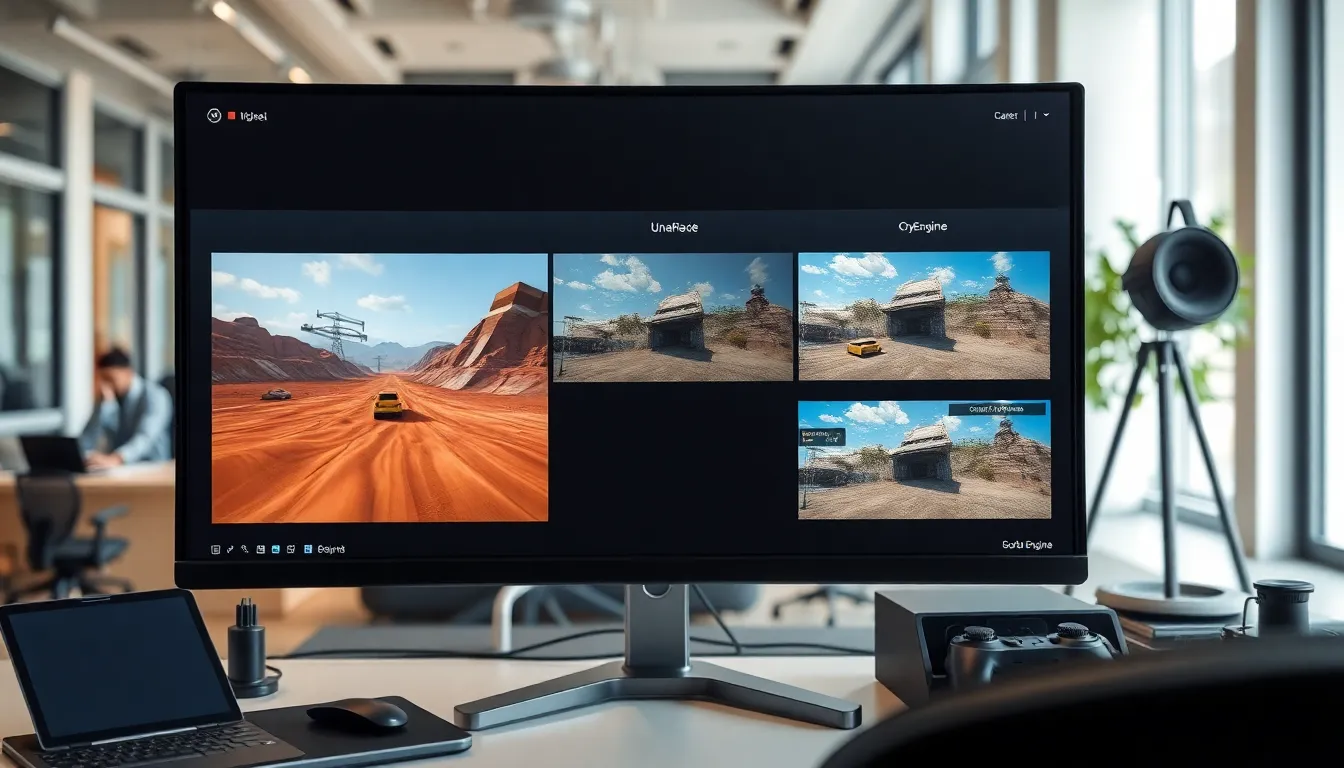In the ever-evolving world of gaming and digital design, graphics engines are the unsung heroes that bring breathtaking visuals to life. But with so many options out there, choosing the right one can feel like trying to pick the best pizza topping—everyone has an opinion, and you might just end up with pineapple on your slice.
Table of Contents
ToggleOverview of Graphics Engines
Graphics engines serve as the backbone of visual rendering in gaming and digital design. Their primary function involves processing complex graphics data to produce high-quality images and animations. Various options exist, each tailored to different needs and preferences, making selection crucial for developers.
Unreal Engine excels in creating immersive environments. It offers advanced visual features, including photorealistic rendering and real-time global illumination. Many developers appreciate its flexibility and extensive asset library.
Unity stands out for its versatility. It supports a wide range of platforms, including mobile, desktop, and console. Developers often choose Unity for its user-friendly interface and strong community support.
CryEngine is recognized for its stunning graphics capabilities. Its focus on realism includes detailed environmental effects like weather patterns and dynamic lighting. Developers interested in high-fidelity visuals often consider CryEngine for their projects.
Godot Engine caters to open-source enthusiasts. It provides a lightweight option with integrated development tools. Programmers favor Godot for its ease of use and customization potential.
Choosing a graphics engine involves assessing project requirements, budget constraints, and target audience. Developers must weigh factors such as performance, scalability, and available features. Each graphics engine presents unique strengths, which, when aligned with project goals, enhance the overall development experience. Understanding these engines’ characteristics aids in making informed decisions.
Key Features to Compare

Selecting the right graphics engine involves understanding specific features critical to project success. The following aspects are essential for comparison.
Performance Metrics
Performance metrics significantly impact user experience. Frame rates, latency, and resource usage are key indicators. Unreal Engine boasts high frame rates, supporting complex scenes seamlessly. Unity offers good performance across platforms, ensuring accessibility. CryEngine excels in rendering detailed environments without compromising performance. Evaluating these metrics helps developers choose engines that align with their project’s needs.
Rendering Techniques
Rendering techniques define the visual quality and realism of projects. Unreal Engine uses advanced techniques like real-time ray tracing for lifelike graphics. Unity supports various rendering pipelines, giving developers flexibility. CryEngine emphasizes photorealistic rendering, capturing intricate details accurately. Godot Engine provides multiple rendering options, catering to different styles. Considering these techniques shapes visual outcomes and impacts player engagement.
Compatibility and Support
Compatibility and support play crucial roles in a graphics engine’s usability. Unreal Engine integrates well with leading 3D modeling software, streamlining workflows. Unity holds strong compatibility across multiple platforms, making it versatile. Developers using CryEngine find robust support for high-end hardware. Godot Engine’s open-source nature fosters a strong community, providing resources. Assessing compatibility ensures that chosen engines harmonize with existing tools and systems.
Popular Graphics Engines
Different graphics engines cater to unique development needs, making the choice crucial for project success. Here’s a look at some of the most popular graphics engines.
Unity
Unity stands out for its versatility and intuitive interface, appealing to both beginners and experienced developers. It supports 2D and 3D game development, allowing users to create diverse experiences with ease. Additionally, Unity integrates with numerous platforms such as PC, consoles, and mobile devices. The engine features a robust asset store, providing ready-made elements that can expedite development. Furthermore, Unity’s strong community offers support, making it easier to troubleshoot and share knowledge. Overall, its flexibility and extensive features give Unity a competitive edge in game development.
Unreal Engine
Unreal Engine is renowned for its advanced visual fidelity and ability to create highly immersive environments. The engine excels in real-time rendering and supports realistic lighting and intricate detail, appealing to developers focused on high-end graphics. Its Blueprint visual scripting system allows for rapid prototyping without extensive programming knowledge, which can enhance workflow for designers. Moreover, Unreal Engine’s strong integration with 3D modeling software streamlines the design process, fostering efficient collaboration among team members. High frame rates and extensive documentation further enhance its attractiveness, positioning Unreal as a top choice for projects aiming for visual impact.
Godot
Godot Engine garners attention for its open-source nature, making it highly customizable and accessible. Developers can modify its source code to better fit project-specific requirements, leading to specialized solutions. Lightweight in design, Godot minimizes system resource usage, enabling smooth performance even on lower-end hardware. Support for both 2D and 3D graphics broadens its application range, allowing users to create diverse game types. Additionally, Godot features a unique scene system that promotes modularity and organization within projects. With an active community contributing to its growth, Godot continues to evolve as a valuable option for developers seeking flexibility and control.
Comparative Analysis
Understanding the strengths and weaknesses of each graphics engine enables developers to make informed decisions tailored to their project needs.
Strengths of Each Engine
Unreal Engine excels in creating immersive environments with stunning visual fidelity, making it a favorite for AAA games. Unity offers versatility, allowing developers to create both 2D and 3D projects, along with a robust asset store that enhances development speed. CryEngine shines in rendering highly detailed graphics, ideal for projects requiring photorealism and realism. Godot Engine stands out for its lightweight design and open-source capabilities, making it accessible for indie developers seeking customization and control.
Weaknesses of Each Engine
Unreal Engine’s complexity can pose a steep learning curve for beginners, potentially delaying project timelines. Unity, despite its advantages, may struggle with performance in high-fidelity environments compared to rivals. CryEngine requires powerful hardware to fully leverage its capabilities, which may not be feasible for all developers. Godot Engine, while flexible, lacks some advanced features found in more established engines, possibly limiting high-end development potential.
Selecting the right graphics engine is a pivotal decision for developers aiming to create engaging visuals. Each engine brings its own set of strengths and weaknesses that cater to different project requirements. Whether prioritizing visual fidelity with Unreal Engine or seeking flexibility with Unity or Godot, understanding these nuances is crucial.
Ultimately, the choice hinges on the specific needs of the project and the developer’s expertise. By thoroughly evaluating performance metrics, rendering techniques, and compatibility, developers can confidently navigate the diverse landscape of graphics engines. This informed approach empowers them to enhance user experience and bring their creative visions to life.




